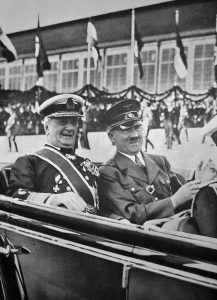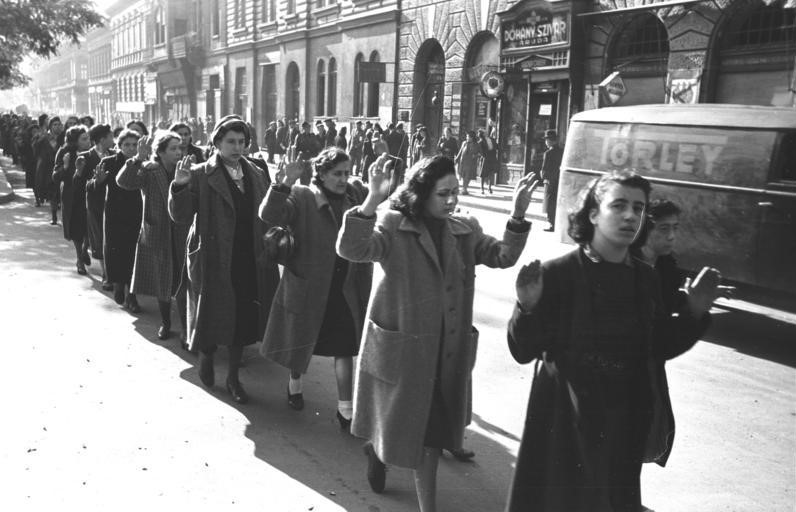Orbán and the Hungarian Holocaust: Historical Distortion for Political Gain?
Under Viktor Orbán’s rule, the history of the Holocaust has increasingly been distorted. By denying and misrepresenting the crucial facts of the Holocaust in Hungary, the aim is to rehabilitate the Hungarian collaborationist government of Admiral Miklós Horthy, the Regent of Hungary during Hitler’s Third Reich, and cleanse the historical record of the Nazi era. In order to explore Hungary’s process of coming to terms with its past, this essay analyses the narratives of the two opposing camps in the debate on historical revisionism towards the Hungarian Holocaust: on one side the revisionists, on the other side those challenging such historical distortions. In particular, it investigates how western media has perceived and responded to the reinterpretation of the Hungarian Holocaust. To this end, this essay analyses articles from major English-language media outlets.
By Dany Levin Prist
Politics versus History: Rewriting the Hungarian Holocaust
In a speech from June 2017, the Hungarian Prime Minister Viktor Orbán described Miklos Horthy, the last Regent of Hungary (1920-1944) as an “exceptional statesman”. After portraying the 1920s and 1930s as “a grave touchstone” of Hungarian history, Orbán claimed that “history did not bury us (after World War One) thanks to a few exceptional statesmen (like) Governor Miklos Horthy”. The Prime Minister argued that “this fact cannot be negated by Hungary’s mournful role in World War Two”.
Admiral Horthy was the leader of the Hungarian collaborationist regime during Hitler’s Third Reich. “Concerning the Jewish question, for all my life, I have been an antisemite, I have never made any contact with Jews. I have found it intolerable that here, in Hungary, every single factory, bank, asset, shop, theatre, newspaper, trade, etc. is in Jewish hands”. With these words, Regent Horthy described his own prejudice in a letter dated 1940 to then-Prime Minister Pál Teleki.
It is not surprising, therefore, that prior to the German occupation of Hungary in March 1944, Horthy degraded Hungarian Jewry to second class citizens by introducing the infamous ‘Numerus Clausus’ that severely limited the access of Jews to universities in 1920. Admiral Horthy also signed nearly 300 anti-Jewish laws and decrees issued by the Hungarian Parliament during the 1930s.
These measures restricted the rights of the country’s Jewish citizens and also claimed over 60,000 Jewish lives by early 1944. In fact, Hungarian authorities murdered Jews on several occasions already before the German occupation. In the summer of 1941, they deported more than 20,000 Jews to the German-occupied Ukraine. In January 1942, the Hungarian military and gendarmerie murdered nearly 1,000 Jews in Újvidék (currently Novi Sad, Serbia) and its vicinity. The Hungarian army personnel also killed many Jews in the labour service. After the German occupation began, Admiral Horthy handed over hundreds of thousands of Jews to the Nazis. Within eight weeks (May to July 1944), he deported over 420,000 Hungarian Jews to Auschwitz-Birkenau: the quickest deportation carried out in the history of the Holocaust. Ninety per cent of those arriving in the concentration camp were murdered immediately.
Orbán’s praise for Horthy was widely-criticized. It is one of a series of recently controversial episodes in which the Prime Minister and his government have sought to reshape the narrative of the Hungarian Holocaust. The international media covered this in the context of an immediate backlash from Hungarian Jewry (represented by the MAZSIHISZ, the Federation of Hungarian Jewish Communities) and other international Jewish organisations.
Another important element in the Hungarian government’s attempt to redirect the interpretation of the Holocaust has been the erection of the “Memorial to the Victims of the German Occupation” in the very centre of Budapest on the occasion of the Hungarian Holocaust Memorial Year (2014), at Liberty Square. Next to triggering an international debate, the controversy around the memorial also showcases the difficulties with which Hungarian society is coming to terms with its past.

Admiral Miklós Horthy (left) with Adolf Hitler (right) in 1938. Admiral Horthy was the leader of the Hungarian collaborationist regime during Hitler’s Third Reich. Photo credit: Public Domain
Victim or perpetrator? A historians’ debate
In Hungary, attempts to distort the history of the Holocaust began soon after the end of the Second World War and were conducted by extremist antisemitic right-wing groups, many of whom came to be identified as “historical revisionists”. Since then, historical revisionism has not only infected the xenophobic nationalist stratum of Hungarian society, but has also been taken up by “respectable” public figures.
One of them is Mária Schmidt, who recently denied the historical facts about the collaboration of Admiral Horthy’s regime with Nazi Germany, by reducing Hungary’s role to that of a victim. Schmidt is the Director-General of the House of Terror Museum in Budapest. The historian and university lecturer was also in charge of overseeing the project of another museum: the House of Fates. Budapest’s new Holocaust memorial museum is another controversial case that drew international attention. Dr. Robert Rozett, the director of Yad Vashem Libraries, pointed out that “visitors to the House of Fates are to be shown and taught that, except for a tiny, criminal and fanatic minority, the citizens of Hungary were essentially blameless for what was inflicted upon their Jewish neighbors.” He is not alone in thinking this. The International Holocaust Remembrance Alliance (IHRA) and the United States Holocaust Memorial Museum in Washington, among other well-known institutions, are also alarmed by the museum’s apparently “distorting” view of history.
In a widely-read article, Schmidt downplayed the tragedy of hundreds of thousands of Jewish Hungarian citizens stating that “as bad as these decisions were, they do not make the [German] invasion and its consequences any less of a tragedy”, thereby seeking to reduce the responsibility of the Hungarian state. In the aftermath of Schmidt’s diatribe, Mária Kovács, history professor at the Central European University in Budapest, dissected Schmidt’s arguments. For Kovács, who referred to the article as “a provocation and declaration of war”, it is evident that without the Hungarian collaborationist regime “the occupying Germans could not have achieved their murderous objectives”.
Lastly, it is also important to point out that the initial refusal to accept political responsibility for Hungary’s involvement in the Holocaust has led to the development of new cultures of commemoration and to an intensive discussion about the past. This debate has been held largely in public and is accessible to the broader population through online media.
The “Memorial to the Victims of the German Occupation”

The ‘Memorial to the Victims of the German Occupation’. Since 2014, the government-sponsored monument has been widely-criticized. It is one of a series of controversial episodes on the narrative of the Hungarian Holocaust involving the Prime Minister Orbán and his government. Photo credit: Public Domain
This long-standing debate within Hungarian society leads us to the events around the 70th anniversary of the Holocaust in Hungary, particularly to the controversial memorial in Szabadság tér. Conceived in 2013 by Orbán’s government as a commemoration of the German occupation of Hungary and dedicated to the “memory of victims,” it depicts a virtuous and innocent Hungary represented by the Archangel Gabriel being attacked by the German imperial eagle.
Jewish leaders, historians and NGOs use the memorial to protest against the right-wing government. Most prominently, they have done so by erecting a counter-monument. Named “Living Memorial” and placed in front of the official one, the counter-monument is made up of personal relics, family photos, hand-written family stories and other personal belongings from victims of the Holocaust. In this way, it contests the official interpretation of the Holocaust, especially in regard to the notion of Hungary as a mere victim of German occupation that relativises the responsibility of Horthy’s Hungary.

The spontaneous counter-monument placed in front of the official memorial. Photo credit: @jjfarquitectos
The victimizing narrative of Orbán’s Government
To understand the way in which the Holocaust has been used in European politics, I
use the concept of the ‘use of history’, introduced by the Swedish historian and researcher Klas-Göran Karlsson in the 1990s. Karlsson developed a “typology of different ways of using history”, which includes assessing the different needs for using history, the different ways for using it, the various interest groups that use it, and the functions history fulfills in society. Karlsson’s typology is useful, therefore, for understanding the positioning of different actors in the public debate about the Holocaust and the Second World War in Hungary.

Mária Schmidt (left) with Viktor Orbán (right) in 2015. Schmidt is the controversial mastermind historian behind the Hungarian government’s interpretation of the Holocaust in Hungary. Photo credit: MTI/MTVA
Mária Schmidt, the mastermind historian behind Orbán’s government, has defended he existence of “alternative interpretations and understandings” that could be “legitimate in a free society”. By stating that “History is not equal to morality”, she has taken a clear step towards what Karlsson has classified as ‘ideological use’ of history, in so far as the focus of this type of history “is not on facts”, “but rather on the grand narrative”. That is the rearrangement of history in order to legitimize the government’s victimizing version of the past. Schmidt, who has labelled the debate around the memorial as “unproductive”, used history ideologically when she argued that “conventional historical wisdom says Hungary was an ally to the Third Reich and, therefore, the Nazis didn’t really invade and occupy us. According to this line of thinking, we should call the Nazi invasion ‘friendly support’”. In following this line of argument, Schmidt ultimately tried to relativize the role played by Hungary under Admiral Horthy’s rule during the Holocaust, affirming that it is conceivable that “someone actively involved in persecuting our Jewish compatriots later became a victim of the war” due to the fact that a war “does not spare the innocent and destroy the sinful”.
Another prominent voice in this debate has been that of the sculptor of the memorial, Péter Párkányi Raab. Raab claimed that the monument could have served as a means of reconciling Jewish and non‑Jewish Hungarians but that “protesters have barred the country from commemoration”. The protesters referred to by him, many of them creators of the Living Memorial, played an important role in the attempt to restore the historical facts of the Holocaust in Hungary. As the purpose of the counter-monument was to offer a narrative of the German occupation different from that represented by the state monument, one can observe here what Karlsson has described as the ‘moral use’ of history. This particular use is based on “indignation at the scant attention given to troubling aspects of history in a society” and aims at reconciliation, rehabilitation and restoration. The counter-monument not only challenged the adjacent official monument and its notion of Hungary as a victim of German occupation; importantly, it defied the legitimacy of the official conception of victimhood by direct references to the suffering of Hungarian Jews.
Hungarians at the mercy of History: the western media’s perceptions
An analysis of the international media coverage of the memorial controversy demonstrates that the mainstream western newspapers generally reflect the anti-government position. According to The Independent, for example, “the allegory is clear – Nazi Germany attacking its innocent Hungarian prey.” McDonald-Gibson states that the memorial’s interpretation of history omits “decades of persecution Hungary’s Jews faced.” At the same time, The Economist emphasises the “bad start” of the Hungarian government’s Holocaust memorial year. The British newspaper quotes Randolph Braham, the recently deceased leading historian on the Holocaust in Hungary, who claimed that the memorial was a “cowardly attempt to distract attention” from Horthy regime’s collaboration and “a brazen drive to falsify history”.
Across the Atlantic, The Wall Street Journal presents a neutral position, by exploring the arguments from both sides. However, while Margit Feher refers to the memorial as “controversial”, she also highlights the official statement of the US Embassy in Budapest to “urge the government to seek an honest, open, and factual assessment of the Holocaust in Hungary”.
“Hungarians have always viewed themselves as at the mercy of history. Is that why they love their strongman prime minister?” is the first sentence of a Foreign Policy (FP) article on “Hungary’s 500-Year-Old Victim Complex”. The image of Hungary as a noble and helpless victim of the malevolent forces of history was, according to James Traub, not only a falsification of the past but an instrument for the politics of the present. From his perspective, Orbán “does not like liberalism and does not think Hungarians have liberalism in them. Rather, he directs his people’s attention to their victimization and to their ancient crusades”. The media seems to generally agree that the memorial establishes a distorted historical narrative reflected in “a sense of collective innocence and of angelic victimhood”.
The Holocaust and Antisemitism: Orbán’s dog-whistle politics
In sum, the events around the memorial highlight the Hungarian government’s failure to create a national consensus on remembrance. At the same time, the diverging interpretations of this one chapter of Hungarian history has led to the absence of a common Holocaust narrative. The government’s position actually offered an opportunity for the protesters to gain visibility and to organize a vocal platform against the distorted version of history represented in the Liberty Square memorial. The controversy brought about competing interpretations of the past. Most importantly, it stimulated a broader debate within Hungarian society about one of the darkest periods of its history.
The mainstream western media generally acknowledged the seriousness of arbitrary attempts to change historical narratives and condemned Orbán’s victimhood narrative for downplaying the responsibility that Hungary had during the Holocaust. This perception is coherent with the media’s general distrust of the conservative nationalistic government of Orbán.
In today’s Hungary, overt antisemitism has been replaced by dog-whistle politics, Holocaust revisionism, and an ‘us-versus-them’ mentality. In Hungarian, there is an expression that antisemitism is like a hidden spring, often imperceptible yet omnipresent, a source that can be tapped by demagogues, polemicists, and politicians. Viktor Orbán and the ruling party Fidesz – led by him since 2003 – have been using antisemitism and historical distortion as political tools. Orbán’s political strategy relies on luring right-leaning voters and avoiding the turbulences from the past. In particular, the campaign against George Soros is another recent, related case in point. Soros is a philanthropist and Holocaust survivor who funds a range of NGOs and civil society groups and who was accused by Orbán of attempting to undermine the Hungarian nation-state. Another example is the awarding of one of the country’s highest honours to Zsolt Bayer, a prominent xenophobic and antisemitic journalist. But while the dog-whistle antisemitism in contemporary Hungarian politics may be instrumental, it is far from innocuous. Orbán’s hostility towards Jews cannot be interpreted as a mere matter of tactics. The official antisemitic narrative is also a product of Orbán’s nationalist exclusivist ideology rather than only a political instrument. Antisemitism is one of the elements of Orbán’s ideology built on the distinction between an ‘us’ and a ‘them’. This ‘otherness’ policy often portrays the ‘others’ – non-Christian Hungarians – as trying to undermine the Hungarian Christian nation – ‘us’. Therefore, future academic studies will have to explore this subject further by focusing on the ambiguities of Orbán’s attitude towards antisemitism: on the one hand disseminating a “Zero Tolerance” policy and promoting good diplomatic relations with Israel, on the other hand using antisemitism and Holocaust revisionism as tool for political gain.
 Dany Levin Prist is a European Studies Master’s student at Maastricht University. He holds a bachelor degree in Law from NOVA University of Lisbon. Dany has also worked as a joint fellow in two Jewish international advocacy organisations based in Brussels.
Dany Levin Prist is a European Studies Master’s student at Maastricht University. He holds a bachelor degree in Law from NOVA University of Lisbon. Dany has also worked as a joint fellow in two Jewish international advocacy organisations based in Brussels.
This article is a revised version of a paper produced for the course Post-war Europe: Political and Societal Transformations within the MA in European Studies at Maastricht University.
Cover image: Captured Jewish women in Wesselényi Street, Budapest, 20–22 October 1944. From May to July 1944 over 420,000 Hungarian Jews were deported to Auschwitz: the quickest deportation carried out in the history of the Holocaust. Photo credit: Bundesarchiv-Bildarchiv
Suggested reference
Dany Levin Prist: Orbán and the Hungarian Holocaust: Historical Distortion for Political Gain? In: RUB Europadialog, 2019. URL: http://rub-europadialog.eu/orban-and-the-hungarian-holocaust-historical-distortion-for-political-gain (17.04.2019).
